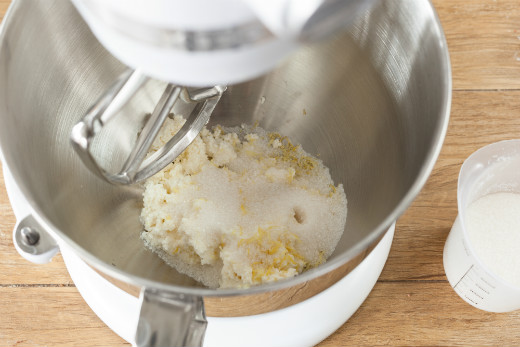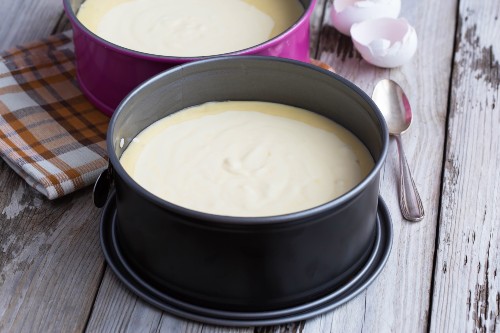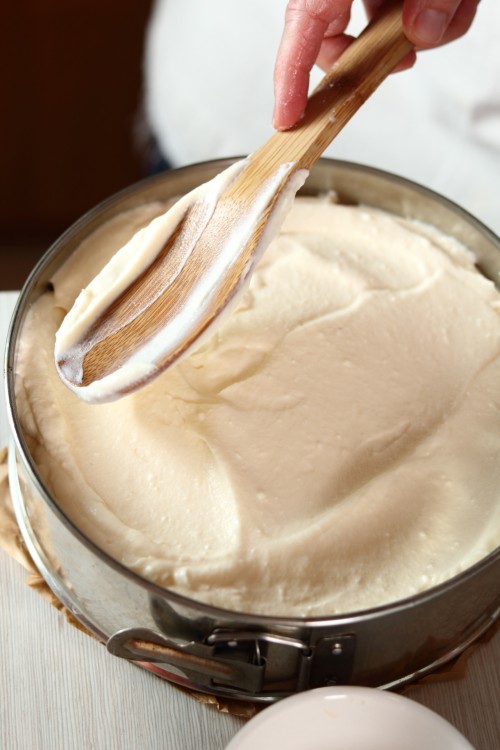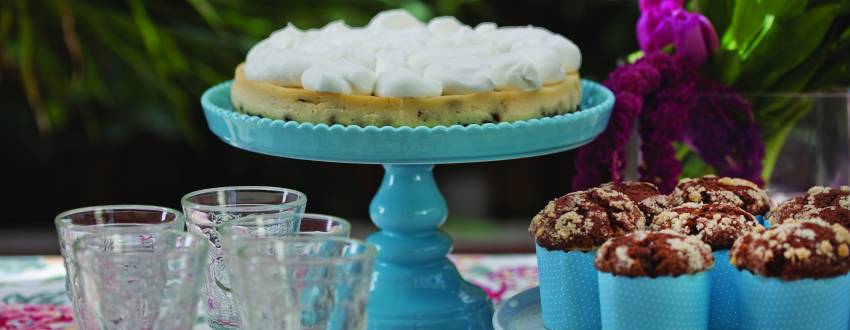One of the signs that Shavuos is coming is your craving for cheesecake is starting to overwhelm you. Cheesecakes should be smooth, thick, creamy and rich in texture and sweet and slightly tangy in taste. Sometimes though, they come out too fluffy, too heavy or even rubbery! With many years’ experience baking cheesecakes professionally, under my belt (literally!), I’m sharing the secrets to a perfect cheesecake!

The following are the basic steps to follow regardless of what ingredients your recipe calls for:
- All ingredients should be room temperature, including the eggs, to properly act as an emulsifier. Cut the bar of cream cheese into chunks and let them soften on the counter.
You can also use whipped cream cheese, but bar cream cheese is a better for proper texture. If you use a food processor, you can use ingredients straight from the fridge, as it incorporates less air into the mixture.
- Crusts should be baked at 325 degrees Fahrenheit/165 degrees Celsius. Mix graham cracker crumbs, melted butter, and a drop of sugar together and press firmly and evenly onto the bottom of a 9-inch springform pan. The bottom and sides of the pan should be greased to allow cake to rise and release evenly from the sides. Use the bottom of a glass or dry measuring cup to do so. For extra flavor, add a handful of chopped walnuts and a pinch or two of cinnamon to the crumbs.
Pre-baking helps to keep the crust intact and adds a crisp texture to complement the smooth custard filling. Bake for approximately 10 minutes or until beginning to brown around edges. Cool before filling. You can also freeze your crust, unbaked, until filling is done.
- Preheat oven (see below). Blend the sugar into the cheese before adding other ingredients to help smooth the cheese and remove any lumps. The mixture should be very smooth before adding other ingredients. This is very important. Add eggs one at a time, mixing on medium speed. Add the rest of the ingredients and mix well.
Do not over-beat the cheesecake batter. You want to aerate the batter, but not too much. Excessive beating can cause the cheesecake to puff up too much during baking then crack during the cooling process.
- You can either bake your cake in a hot oven 475 degrees Fahrenheit/240 degrees Celsius for about 10 minutes (if it browns too quickly, cover with parchment paper or foil), and then lower temp to 350 degrees Fahrenheit/180 degrees Celsius for about 50 minutes OR bake the entire time between 325 degrees Fahrenheit/160 degrees Celsius and 350 degrees Fahrenheit/180 degrees Celsius but use a water bath or bain-marie (a container holding hot water into which a pan is placed for slow cooking).
- To create a water bath, wrap the springform pan in two layers of heavy duty foil to prevent any water from seeping into the cheesecake. Place the pan into a larger pan that contains enough water to go up the sides of the spring form about 1 inch.
Alternately, you can put a large pan with water on the bottom of your oven. Either way, you’ll have a creamier and moister cake and the surface of the custard stays moist. Just like in a restaurant!
- Before baking (or after the first 10 minutes on high temp), run the point of a sharp knife between the cheesecake mixture and the side of the pan about 1/2–1 inch down. This will help prevent cracks. This should also be done after removing from the oven , but then run it completely down and around edges.
- Do not open the oven while baking. Drafts can cause cracks. To partially cool, turn the oven off after baking, and leave the cake there for another hour.
- The baking time in a recipe is just a guideline. A cheesecake is done when it is barely beginning to brown. The center should still be soft and jiggly. It firms up as it cools. Do not test, as you would a regular cake, with a sharp knife or toothpick in the center.
- Let cake completely cool before refrigerating for optimum results.
- To cut the cake, use unflavored dental floss or a sharp straight-edged knife. Dip in hot water, dry and slice. Clean after each cut.
- Cheesecake freezes well. Just be sure to wrap it as air-tight as possible. However, do not top or frost before freezing.

What if…
- The batter is lumpy?
Scrape the bowl often with a spatula to incorporate all the little bits of cream cheese. Ingredients must be room temperature to help prevent that from happening.
- Your crust is soggy or crumbly?
Prebaking the crust makes it stronger and firmer. Also pressing the crumbs firmly keeps the crust together.
- Your cheesecake cracks anyway?
Top with sour cream and sugar and bake an additional five minutes. Or drizzle with caramel topping and a sprinkle of candied pecans. Or top with blueberry/cherry pie filling.
- It’s hard to slice?
After it sets, it should be chilled at least three hours before slicing. Keep in the springform pan until ready to serve it.

A Note on Cheeses:
· If you use quark cheese, make sure it is drained well.
· Heavy cream or sour cream in the batter breaks up the heaviness of the cream cheese, giving the cake a smooth and creamy texture.
· Full fat dairy yields the best results, but you know I’ve baked with reduced fat dairy, used eggs- whites mostly, and less sugar, and we loved it!





